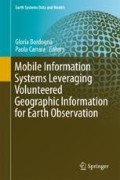Abstract
Since OpenStreetMap (OSM) appeared more than ten years ago, new collaborative mapping approaches have emerged in different areas and have become important components of localised information and services based on localisation. There is now increased awareness of the importance of the space-time attributes of almost every event and phenomenon. Citizens now have endless possibilities to quickly geographically locate themselves with an accuracy previously thought impossible. Based on these societal drivers, we proposed a number of collaborative mapping experiments (“mapping parties”) to delegates of a large open-source geospatial conference and to citizens of the conference’s host city during July 2015. These mapping parties had a wide conceptual range from VGI (Volunteered Geographic Information) to geo-crowdsourcing (involuntary crowd-contributed geographic content). Specifically, the mapping parties were: (1) “traditional” OSM mapping, (2) indoor mapping and localisation, (3) emotional mapping of cities, (4) game-based validation of land cover data sets and (5) sensing the city and conference implicitly from Twitter. In this chapter, we outline the aims, structure and implementation of these experiments. We discuss the key outcomes and lessons learned from each of the mapping experiments in order to demonstrate the commonalities and also the differences between experiments. We consider future research directions for collaborative mapping approaches.
Access this chapter
Tax calculation will be finalised at checkout
Purchases are for personal use only
Notes
References
Goodchild, M. F. (2007). Citizens as sensors: The world of volunteered geography. GeoJournal, 69(4), 211–221.
Neis, P., & Zipf, A. (2012). Analyzing the contributor activity of a volunteered geographic information project: The case of OpenStreetMap. ISPRS International Journal of GeoInformation, 1, 146–165.
Soden, R., & Palen, L. (2014). From crowdsourced mapping to community mapping: The post-earthquake work of OpenStreetMap Haiti. In: Proceedings 11th International Conference on the Design of Cooperative Systems (COOP 2014), May 27–30 2014, Nice, France (pp. 311–326). Springer International Publishing.
Haklay, M., & Weber, P. (2008). OpenStreetMap: User-generated street maps. IEEE Pervasive Computing, 7(4), 12–18.
Perkins, C., & Dodge, M. (2008). The potential of user-generated cartography: A case study of the OpenStreetMap project and Manchester mapping party. North West Geography, 8(1), 19–32.
Hristova, D., Quattrone, G., Mashhadi, A. J. & Capra, L. (2013). The life of the party: Impact of social mapping in OpenStreetMap. In: Proceedings 7th AAAI Conference on Weblogs and Social Media (ICWSM 2013), July 8–11 2013, Boston, MA, USA.
Mooney, P., Minghini, M., & Stanley-Jones, F. (2015). Observations on an OpenStreetMap mapping party organised as a social event during an open source GIS conference. International Journal of Spatial Data Infrastructures Research, 10, 138–150.
Huang, H., Klettner, S., Schmidt, M., Gartner, G., Leitinger, S., Wagner, A., et al. (2014). AffectRoute – Considering people’s affective responses to environments for enhancing route planning services. International Journal of Geographical Information Science, 28(12), 2456–2473.
Barrett, L. (2006). Valence is a basic building block of emotional life. Journal of Research in Personality, 40(1), 35–55.
Russell, J. (2003). Core affect and the psychological construction of emotion. Psychological Review, 110(1), 145–172.
Spencer, E. H. (2015). How to analyze Likert and other rating scale data. Currents in Pharmacy Teaching and Learning, 7(6), 836–850. ISSN 1877–1297, http://dx.doi.org/10.1016/j.cptl.2015.08.001.
Russell, J., & Pratt, G. (1980). A description of the affective quality attributed to environments. Journal of Personality and Social Psychology, 38(2), 311–322.
Chen, J., Chen, J., Liao, A., Cao, X., Chen, L., Chen, X., et al. (2014). Global land cover mapping at 30 m resolution: A POK-based operational approach. Remote Sensing: ISPRS J. Photogram.
Brovelli, M. A., Molinari, M. E., Hussein, E., Chen, J., & Li, R. (2015). The first comprehensive accuracy assessment of GlobeLand30 at a national level: Methodology and results. Remote Sensing, 7, 4191–4212.
Credali, M., Fasolini, D., Minnella, L., Pedrazzini, L., Peggion, M., & Pezzoli, S. (2011). Tools for territorial knowledge and government. In: D. Fasolini, S. Pezzoli, V. M. Sale, M. Cesca, S. Coff ani, & S. Brenna (Eds.), Land cover changes in Lombardy over the last 50 years (pp. 17–19). Milano: ERSAF.
Brovelli M. A., Celino I., Molinari M. E., & Venkatachalam V. (2015). Land cover validation game. Geomatics Workbooks no. 12 – FOSS4G Europe Como 2015 (pp. 153–157).
Von Ahn, L. (2006). Game with a purpose. IEEE Computer, 39(6), 92–94.
Arnaboldi, M., Brambilla, M., Cassottana, B., Ciuccarelli, P., Ripamonti, D., Vantini, S., & Volonterio, R. (2016). Studying multicultural diversity of cities and neighborhoods through social media language detection. In: CityLab Workshops of the Tenth International AAAI Conference on Web and Social Media (ICWSM 2016), Cologne, Germany. AAAI Press, Palo Alto, California. ISBN 978-1-57735-768-1.
Brambilla, M., Ceri, S., Della Valle, E., Volonterio, R., & Acero Salazar, F. X. (in press). Extracting emerging knowledge from social media. In: 26th International World Wide Web Conference (WWW 2017), April 2017, Perth, Australia.
Acknowledgements
We want to warmly thank all participants to FOSS4G Europe 2015 who were so enthusiastically involved in all the mapping parties, giving us also the possibility of testing these new collaborative ways of collecting geospatial data. The support of EU COST Action IC1203 “European Network Exploring Research into Geospatial Information Crowdsourcing: software and methodologies for harnessing geographic information from the crowd (ENERGIC)” is also gratefully acknowledged.
Author information
Authors and Affiliations
Corresponding author
Editor information
Editors and Affiliations
Rights and permissions
Copyright information
© 2018 Springer International Publishing AG
About this chapter
Cite this chapter
Brovelli, M.A. et al. (2018). Mapping Parties at FOSS4G Europe: Fun, Outcomes and Lessons Learned. In: Bordogna, G., Carrara, P. (eds) Mobile Information Systems Leveraging Volunteered Geographic Information for Earth Observation. Earth Systems Data and Models, vol 4. Springer, Cham. https://doi.org/10.1007/978-3-319-70878-2_1
Download citation
DOI: https://doi.org/10.1007/978-3-319-70878-2_1
Published:
Publisher Name: Springer, Cham
Print ISBN: 978-3-319-70877-5
Online ISBN: 978-3-319-70878-2
eBook Packages: Earth and Environmental ScienceEarth and Environmental Science (R0)

